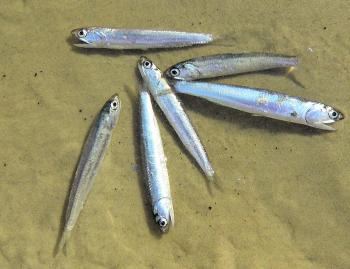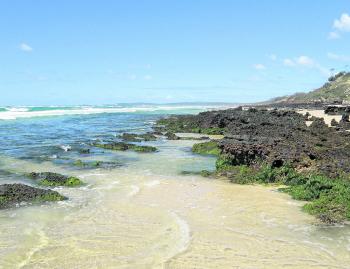Christmas holidays already! Somebody please tell me where has the year has gone? Before looking into the fishing prospects at Fraser Island and Hervey Bay, I need to eat a little humble pie.
In my November column, written well before the end of the tailor season, I suggested that the 2015 season might not go down in the record books, based on a few earlier months. Wrong! Just when we thought things were as good as over, they decided it was time to put in a proper appearance along Fraser’s eastern coast. I am sure it wasn’t a coincidence that huge bait balls of anchovies were moving along the inshore waters at this time. So much so that thousands were being washed up along the beach. Great reports flooded in from right along the ocean beach. Anglers using conventional equipment and WA pilchards were taking their share but anglers using metals and long casts were scoring the better fish.
The Christmas holiday period is one of the busiest times for Fraser Island, particularly between Christmas and New Year. However, it might be surprising to some that Easter and the September holidays seriously rival Christmas for visitor numbers. In April and September weather is usually kinder, and of course September brings in the tailor devotees. December and January can be a bit more on the warm side and there can be the nuisance of March flies.
Having said that, for the comfort of both fish and angler, the best plan is to fish in the cool of the early mornings and late afternoons, or at night. Dart, bream, tarwhine, flathead and whiting can be expected in the gutters, but I need to say that this year whiting catches have been disappointing. I have mentioned in previous columns that dingos can become your company on the beach at night. I have never been threatened by the presence of a dingo sitting on the beach watching me fish, but as much as I like to fish the shallow gutters at night, I now prefer to do so in company with one or more other anglers.
The western beaches of Fraser Island are also very popular with camping families at this time of the year. From the eastern beach there is now only one way to cross the island, this being the Woralie track that heads inland from the beach a few kilometres north of the wreck of Maheno. With the Happy Valley to Moon Point road now closed, the beach from Moon Creek to Coongul Creek is no longer safely accessible. The western beach can turn on some good fishing for whiting, flathead and bream at this time of the year, but seasonal weed infestation of inshore waters can be a problem.
Last month in our journey north along Fraser’s eastern beach, we reached Ngkala Rocks. It is interesting and certainly justifiable at the location of the warning sign indicating the remoteness of the northern part of the island. Very occasionally the build up of sand allows for vehicle access in front of the Ngkala Rocks.
This was the case a few months ago, but this path was only open for about an hour either side of low water. More often the bypass track needs to be taken. This doesn’t usually present too much of a problem for well-equipped, powerful 4WDs with tyres pressures down to about 15psi. The most challenging situation is often the approach track returning at the northern end. From the southern end, the track passes through a rocky cutting, then drops into a soft sandy valley before climbing the dune ridge, then down to the northern beach.
Not too much of a problem unless another vehicle is met half-way through in the sandy valley. I write with bitter experience being one of the many who have needed to be snatched out of trouble here. The best advice I can give here is to have a member of the party walk through to the end of the track to make sure a clear run is possible.
Ngkala Rocks is one of a few coffee rock outcrops along the east coast. As well as turning on great fishing for the usual beach species, the rocky areas can produce reef species such as spotted perch, snapper and occasionally grassy sweetlip.
From Ngkala Rocks it is usually a trouble free run to Sandy Cape but depending on conditions some simple bypasses around Browns Rocks may be required. At Sandy Cape the ocean beach comes to its northern extremity but the moving sand continues to form the Great Sandy Spit with its shallow and treacherous channels that careful boaties use to reach the legendary fishing grounds to the east. From the cape, turning east presents an entirely different beach and calmer seas. About 2.5km east of the cape we reach the track leading to the Sandy Cape lighthouse. Unfortunately, this is the end of the road for us as the beach beyond to Rooney Point, and then south to Wathumba Creek is closed to the public. Acknowledging the problems that can arise in a remote area, I see this as just another way of locking up the northern parts of Fraser Island.
Many visitors to Hervey Bay are equipped with vessels that are able to make the trip into the northern parts including Platypus Bay. During the Christmas holidays, most will be chasing tuna, spotted mackerel and other pelagics. Inshore reefs around Gatakers Bay, Point Vernon, Scarness, Round Island, Woody Island and the Picnics should be worth some attention. This is the stage of the summer season when a very good class of grassy sweetlip move in over the shallows. There should also be plenty of blackall, moses perch as well as black-spot and purple tuskfish. The reefs fish best in the very early morning, just on dusk and to some extent, into the night. Most of these species will take just about any bait including pilchards, hardiheads, squid, cuttlefish, yabbies, prawns and cut baits. However, seriously targeting black-spot tuskfish (blueys) almost demands the use of small rock crabs.
Just 20 minutes south of Hervey Bay by road, River Heads is the base for Fraser Island barges to Kingfisher Bay and Woongoolbver Creek. There are also two boat ramps, one narrow one facing the bay and the other, somewhat more substantial, facing the inside of the river. The increasing popularity of these ramps is certainly related to the booming population of Hervey Bay City, in particular that of the suburb of River Heads.
Unfortunately the ramps and more particularly the limited trailer parking spaces on this very compact peninsula, cannot keep pace with demands. At busy times it is not uncommon to see vehicles and trailers backed up along the road leading to the ramps. This is exacerbated by the presence of single vehicles whose passengers have taken the transport to Kingfisher Bay Resort. To their credit, the local council has made some improvements to the approach road by widening and providing a few more reasonable parking spaces. I certainly wouldn’t desire to discourage fishers from accessing this fishery, but I would suggest the wisdom of the early bird at this very busy time of the year.
The mouths of the Mary and Susan rivers meet at River Heads. This estuary and its feeder streams offer very diverse fishing opportunities and this is a topic that I would like to do justice to in a future edition of QFM, so stay tuned. For the time being I need to say that there have been excellent reports in the spring season.
Post spawning yellowfin bream have been thinning out as they return to their upriver haunts while late spawning pikey bream are still being taken around South Head and along the deep mud banks upstream in the Susan River.
Flathead are plentiful but are best targeted on the smaller tides when visibility is high.
Blue salmon have returned to form after a lull during the colder months.
Whiting anglers are doing well in Shell Gutter, just seaward of River Heads.
There have been some encouraging reports of javelin, mostly from well upstream in the Susan River while on the deep ledges at River Heads, specialist anglers have been scoring some great estuary cod.
Wishing everyone a wonderful Christmas and great start to 2016. A few PBs would be good too!
Reads: 1457
Anchovies washed ashore on Fraser’s ocean beach.

Ngkala Rocks is impassable on most tides.




